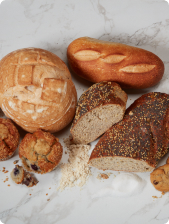
Frozen dough has revolutionized the baking industry, providing both commercial bakers and consumers with unparalleled convenience and quality. By extending the shelf life of baked goods to several months, frozen dough allows bakers to prepare in bulk, reducing daily workload and minimizing waste. For consumers, this means enjoying fresh-baked products anytime with consistent taste and texture. However, the freezing process poses challenges that can affect the final product’s quality. This Q&A article with our Director of Ingredient Technology & Applications, Jenn Adams, delves into the benefits and hurdles of using frozen dough, and how hydrocolloids play a vital role in maintaining its quality and texture.
What benefits does the use of frozen dough provide bakers and their customers?
Frozen dough extends the shelf life of baked goods to 4-6 months, much longer than the usual 21 days for fresh dough. This means bakers can prepare larger batches ahead of time, saving on daily work and reducing waste. For customers, it means they can enjoy fresh-baked products anytime with consistent quality and convenience. Overall, frozen dough is practical and cost-effective for both bakers and consumers.
What challenges does the freezing process present to the texture and quality of baked products?
The freezing process can lead to the formation of ice crystals within the dough, which compromises the dough’s structural integrity, disrupts gas retention, and diminishes its overall quality. Temperature fluctuations that cause repeated freeze-thaw cycles exacerbate these effects, further impacting the texture, flavor, and sensory attributes of the final baked product. These physical and chemical changes can result in a product with reduced quality and consistency.
How does the use of gums/hydrocolloids help maintain proper texture in frozen dough applications?
Gums and hydrocolloids improve the texture of frozen dough by strengthening the gluten network and increasing dough viscosity, which helps manage moisture migration. Additionally, they act as cryoprotectants, reducing the size and number of ice crystals that form during freezing. This helps preserve yeast activity and overall dough quality, ensuring a better final texture in baked products.
What gums/hydrocolloids are commonly used in frozen dough applications, and what benefits do each provide?
In frozen dough, pectin controls moisture migration and ice crystal formation, creating a softer crumb, especially in par-baked doughs. Locust bean gum reduces proofing time, improving efficiency, while carboxymethylcellulose (CMC) and gum Arabic enhance dough volume and quality. Each hydrocolloid contributes to maintaining texture and performance in frozen dough.
How can bakers best incorporate these gums/hydrocolloids to maximize their effectiveness in frozen dough?
Bakers should use hydrocolloids at recommended levels to avoid excessive water absorption, which can disrupt starch and protein hydration. Since hydrocolloids are effective at low concentrations, they generally won’t cause issues in standard formulations. It’s important to test the impact of the chosen hydrocolloid or hydrocolloid blend throughout the product’s shelf life to ensure optimal performance and quality.
How can artisan-style frozen doughs benefit from the use of gums/hydrocolloids?
Artisan-style doughs, often valued for their minimal ingredient lists and natural appeal, can benefit from gums and hydrocolloids by enhancing dough quality while maintaining a clean label. Ingredients like gum Arabic and locust bean gum can replace more complex or chemical-sounding dough conditioners, meeting consumer expectations for simplicity without compromising on performance.
What are some potential challenges or factors bakers should consider when incorporating these ingredients?
Bakers should ensure proper hydration and mixing to prevent clumping and manage the dosage to avoid unwanted textures. They will also need to look at potential interactions with other ingredients, consider the sensory impact on taste and mouthfeel, and balance consumer preferences, regulatory requirements, and cost impact.
Get a quote, sample, or additional information on the gums and hydrocolloids we supply the baking industry with.



